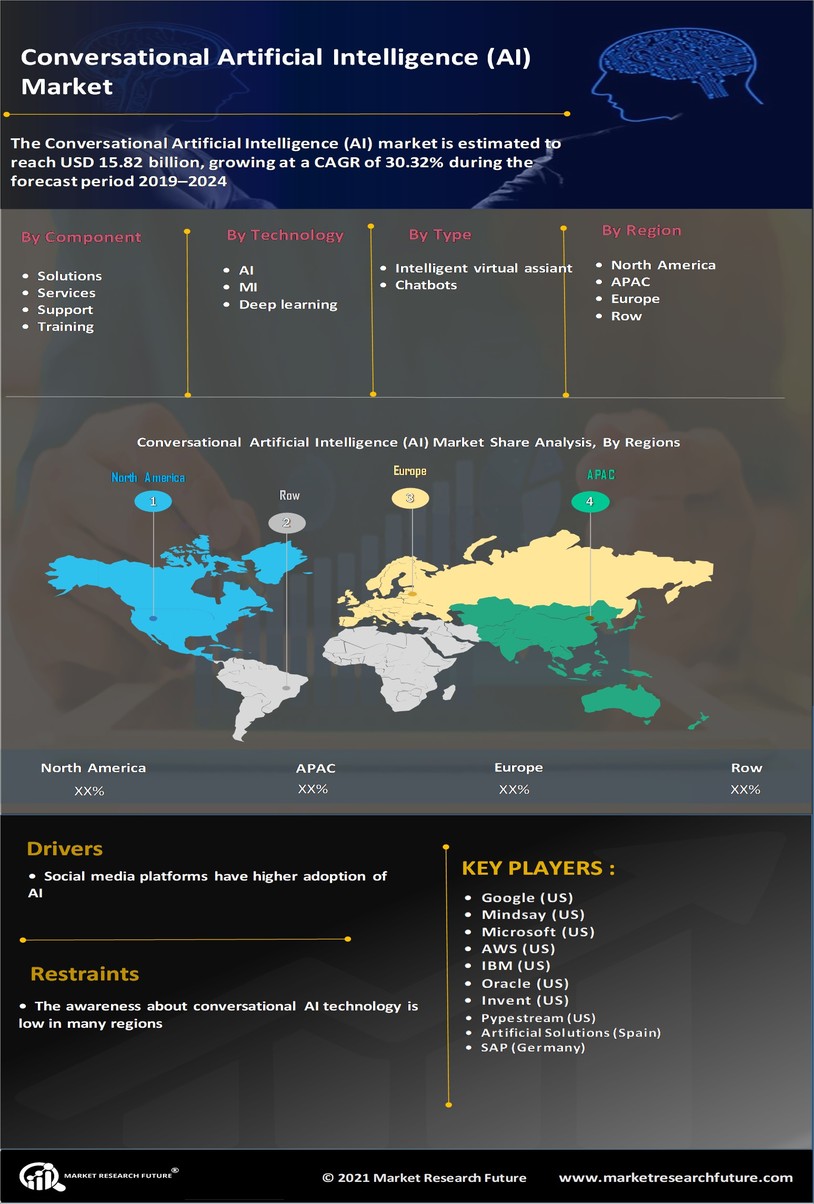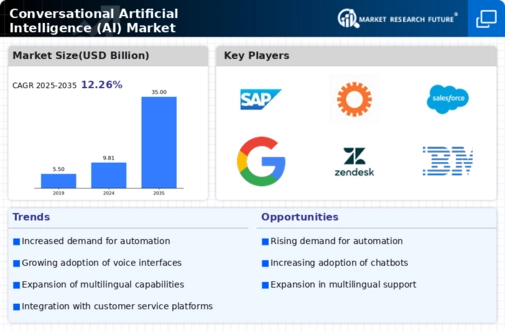Growing Need for Data-Driven Insights
The growing need for data-driven insights is a crucial driver in the Conversational Artificial Intelligence (AI) Market. Organizations are increasingly leveraging AI to analyze customer interactions and derive actionable insights. This data-centric approach enables businesses to tailor their offerings and improve customer engagement strategies. The market for AI analytics is projected to grow significantly, with estimates suggesting it could reach USD 40 billion by 2025. As companies recognize the value of harnessing conversational data to inform decision-making, the demand for AI-driven analytics tools is likely to rise. This trend not only enhances operational efficiency but also positions organizations to better meet customer needs, thereby fostering growth in the Conversational Artificial Intelligence (AI) Market.
Advancements in Natural Language Processing
Advancements in Natural Language Processing (NLP) technology are significantly influencing the Conversational Artificial Intelligence (AI) Market. Enhanced NLP capabilities enable AI systems to understand and respond to human language with greater accuracy and context. This has led to a surge in the deployment of conversational agents across various sectors, including healthcare, finance, and retail. The NLP market is expected to grow at a compound annual growth rate of 20% through 2025, indicating a robust demand for sophisticated conversational interfaces. As organizations strive to improve user engagement and streamline communication, the role of NLP in conversational AI becomes increasingly critical. This evolution not only enhances user experience but also propels the growth trajectory of the Conversational Artificial Intelligence (AI) Market.
Expansion of E-commerce and Digital Services
The expansion of e-commerce and digital services is a driving force in the Conversational Artificial Intelligence (AI) Market. As online shopping continues to gain traction, businesses are increasingly adopting conversational AI to enhance customer interactions and streamline the purchasing process. The e-commerce sector is projected to reach USD 6.5 trillion by 2023, underscoring the importance of effective customer engagement strategies. Conversational AI Market solutions, such as chatbots and virtual assistants, play a vital role in guiding customers through their shopping journey, answering queries, and providing personalized recommendations. This integration not only improves customer satisfaction but also drives sales, thereby contributing to the overall growth of the Conversational Artificial Intelligence (AI) Market.
Rising Demand for Customer Support Automation
The increasing demand for customer support automation is a pivotal driver in the Conversational Artificial Intelligence (AI) Market. Businesses are increasingly adopting AI-driven chatbots and virtual assistants to enhance customer service efficiency. According to recent data, the market for AI in customer service is projected to reach USD 1.3 billion by 2025. This trend is fueled by the need for 24/7 support and the ability to handle multiple inquiries simultaneously, which traditional methods struggle to achieve. As companies seek to improve customer satisfaction and reduce operational costs, the integration of conversational AI solutions becomes essential. This shift not only streamlines operations but also allows for a more personalized customer experience, thereby driving growth in the Conversational Artificial Intelligence (AI) Market.
Increased Adoption of Voice-Activated Assistants
The increased adoption of voice-activated assistants is a notable driver in the Conversational Artificial Intelligence (AI) Market. With the proliferation of smart devices and home automation systems, consumers are increasingly utilizing voice commands for various tasks. Research indicates that the voice recognition market is anticipated to reach USD 27 billion by 2026, reflecting a growing preference for hands-free interaction. This trend is reshaping how businesses engage with customers, as voice-activated AI solutions offer a more intuitive and accessible means of communication. As organizations recognize the potential of voice technology to enhance user experience and operational efficiency, investment in conversational AI solutions is likely to escalate, further stimulating growth in the Conversational Artificial Intelligence (AI) Market.


















Leave a Comment